These pretty Easter sugar cookies are gently flavoured with vanilla, baked to perfect and then topped with sugar paste in perfectly marbled pastel shades.
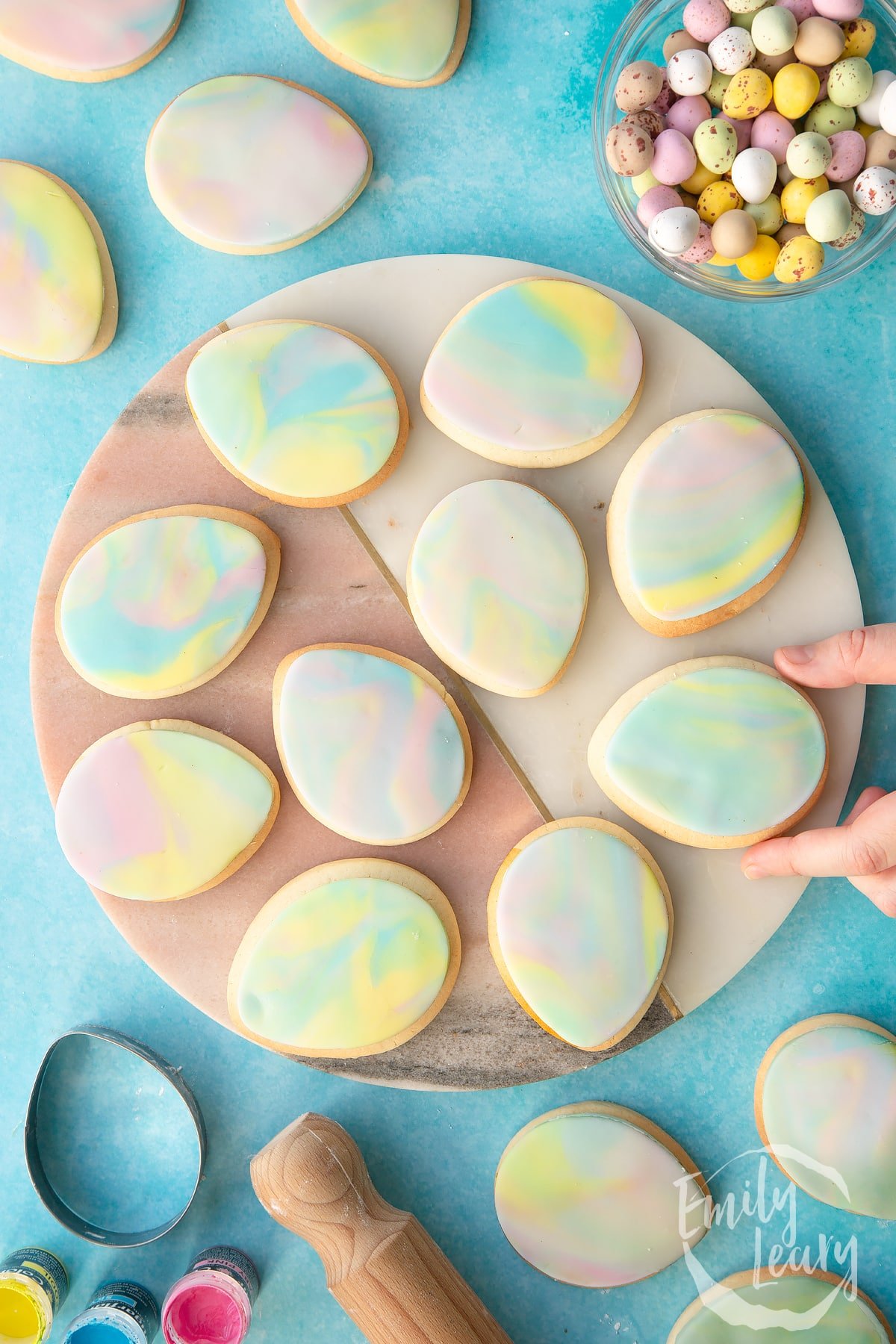
These lovely Easter biscuits start with one of my favourite sugar cookie recipes. First, you'll whisk butter, sugar, egg and vanilla together, then sift in flour, baking powder, salt and bicarb.
Mix together and you'll have the perfect sugar cookie dough, ready to roll out, cut into egg shapes and bake!
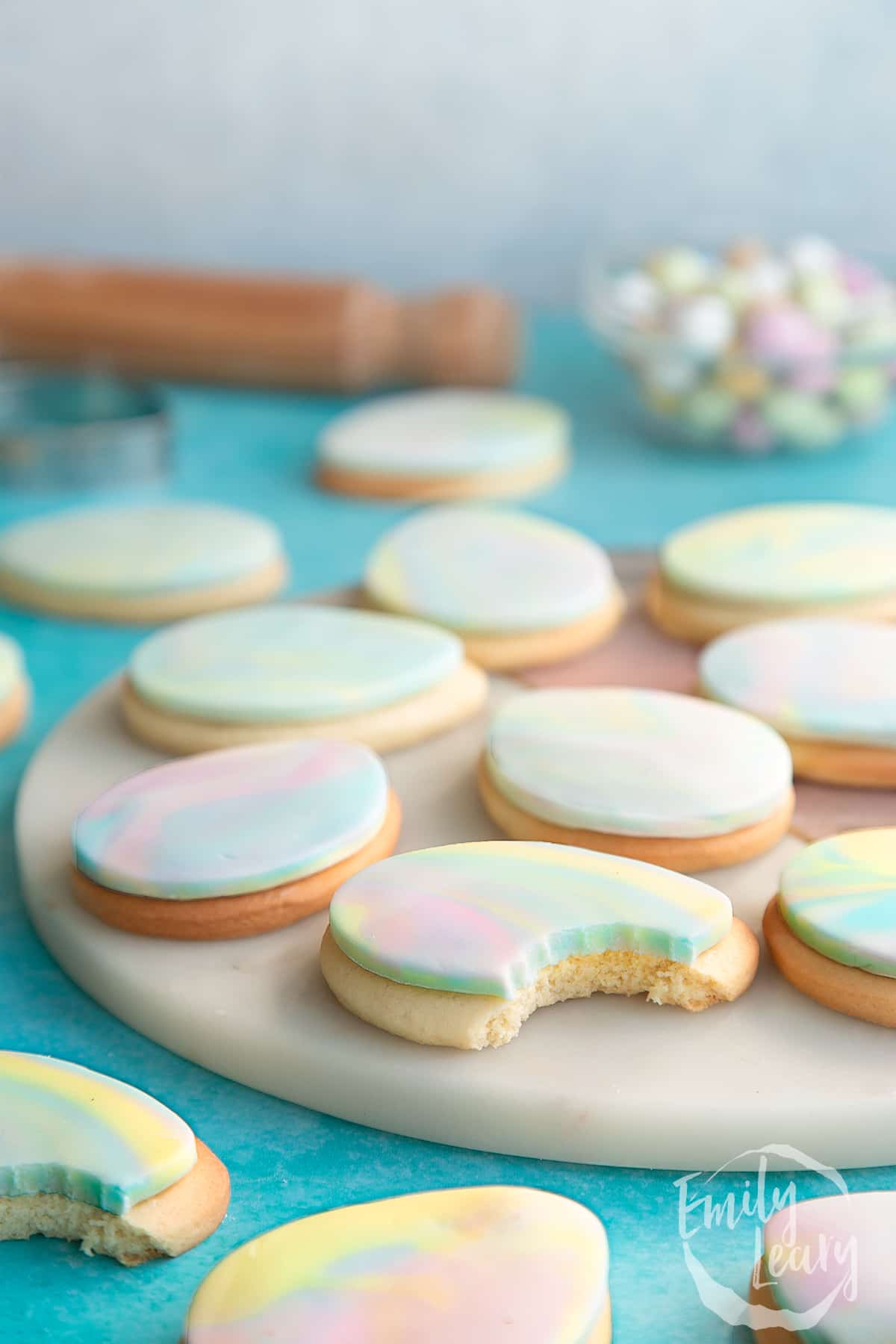
For the decoration, you'll use a drop of food colouring to create three pastel shades, then gently knead them together to produce a pastel effect. Then it's just a case of rolling out your marbled sugar paste, cutting into egg shapes and using to top your sugar cookies.
These are such simple but effective Easter sugar cookies. Here's the full recipe, complete with step-by-step photos to help you every step of the way.
Ingredients
For the sugar cookie dough
- 110 g (1 stick) slightly salted butter cubed
- 100 g (½ cup + 1 tbsp) white caster sugar (superfine sugar)
- 1 medium free range eggs
- ½ tsp vanilla extract
- 250 g (1⅔ cups) plain white flour (all purpose flour)
- ¼ tsp bicarbonate of soda (baking soda)
- ¼ tsp baking powder
- ¼ tsp salt
To decorate the Easter sugar cookies
- 1 tsp cornflour (cornstarch) for dusting
- 500 g (18 oz) white sugar paste vegetarian, if required
- yellow, blue and pink food colouring to produce pastel shades
- 2 tbsp icing sugar (powdered sugar)
Equipment
- 8.25 x 6.25cm (3.25 x 2.5") egg-shaped cookie cutter
Instructions
Make the cookie dough
Preheat the oven to 200C (180C fan assisted, 400F).
Put the butter, sugar, eggs and vanilla in a mixing bowl.
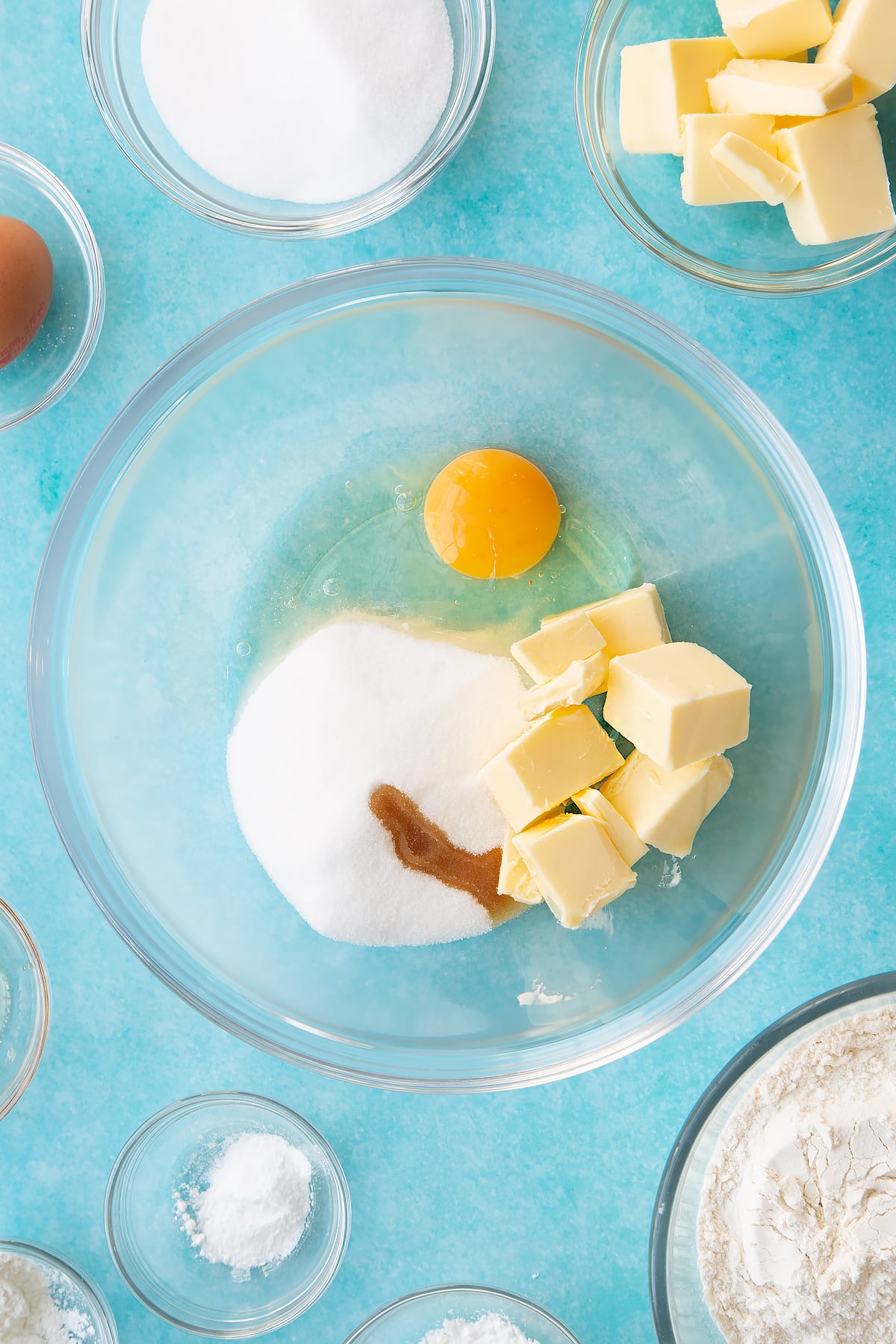
Whisk until fluffy and pale.
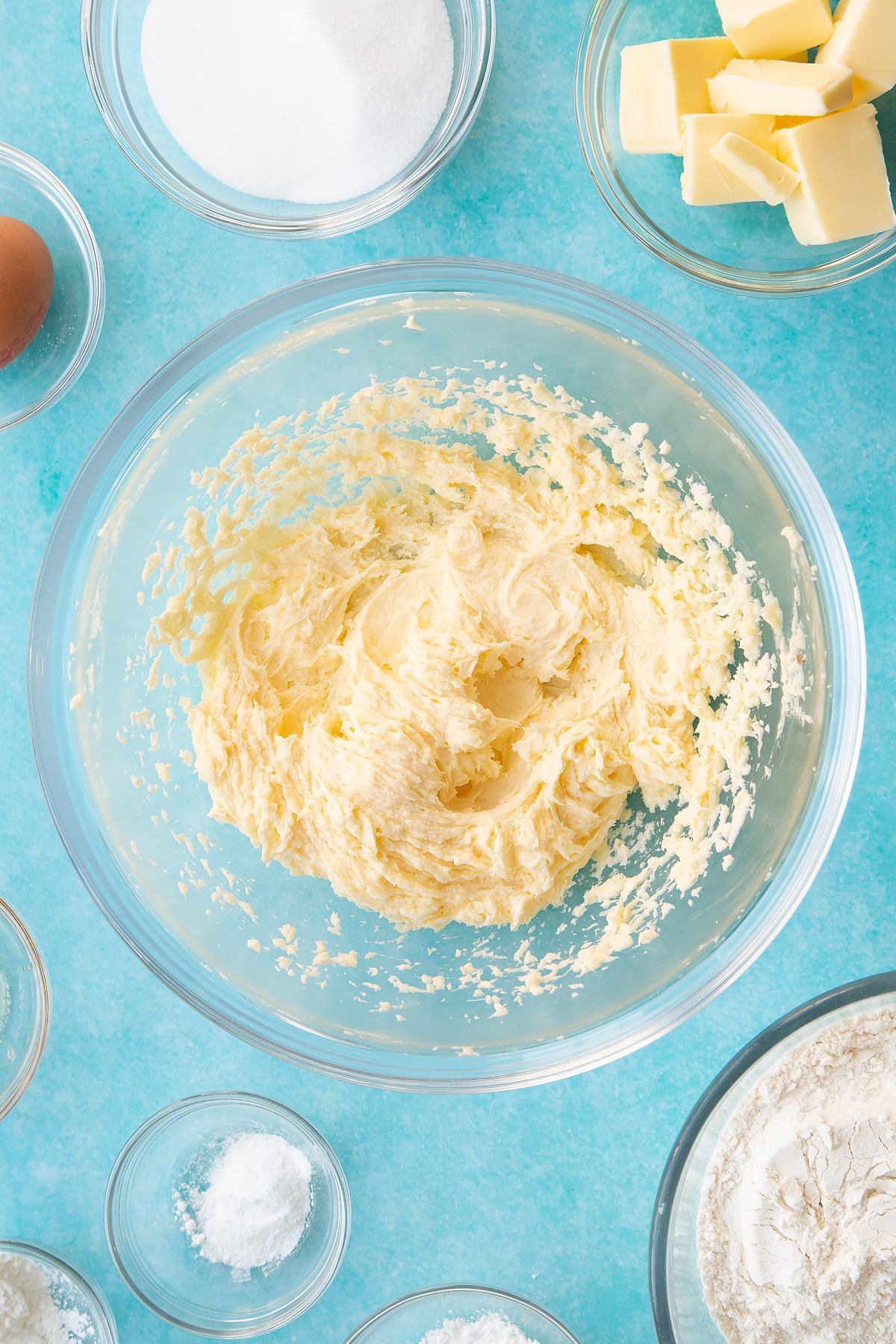
Sift in the flour, baking powder, salt and bicarbonate of soda.
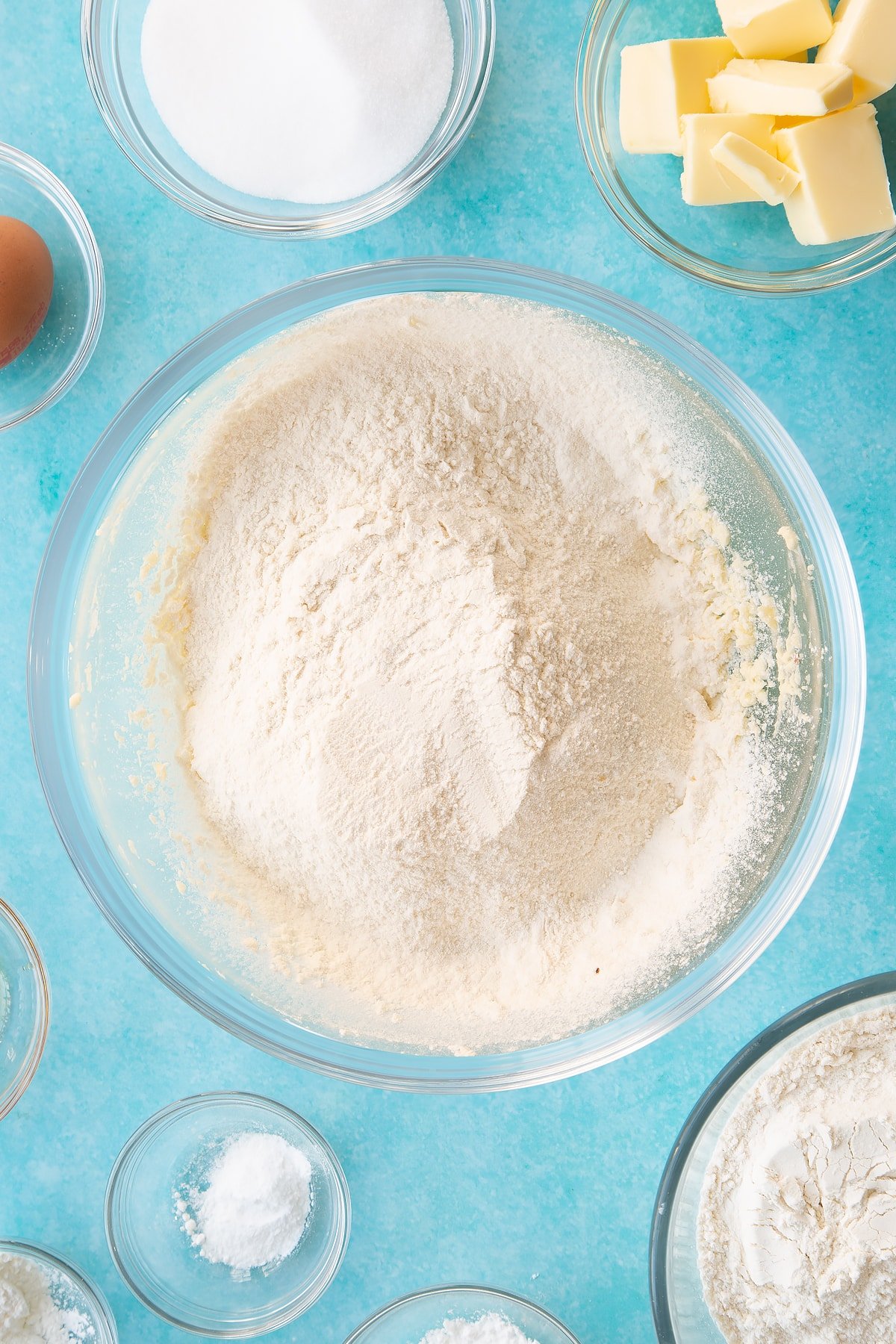
Stir until fully combined and clumpy
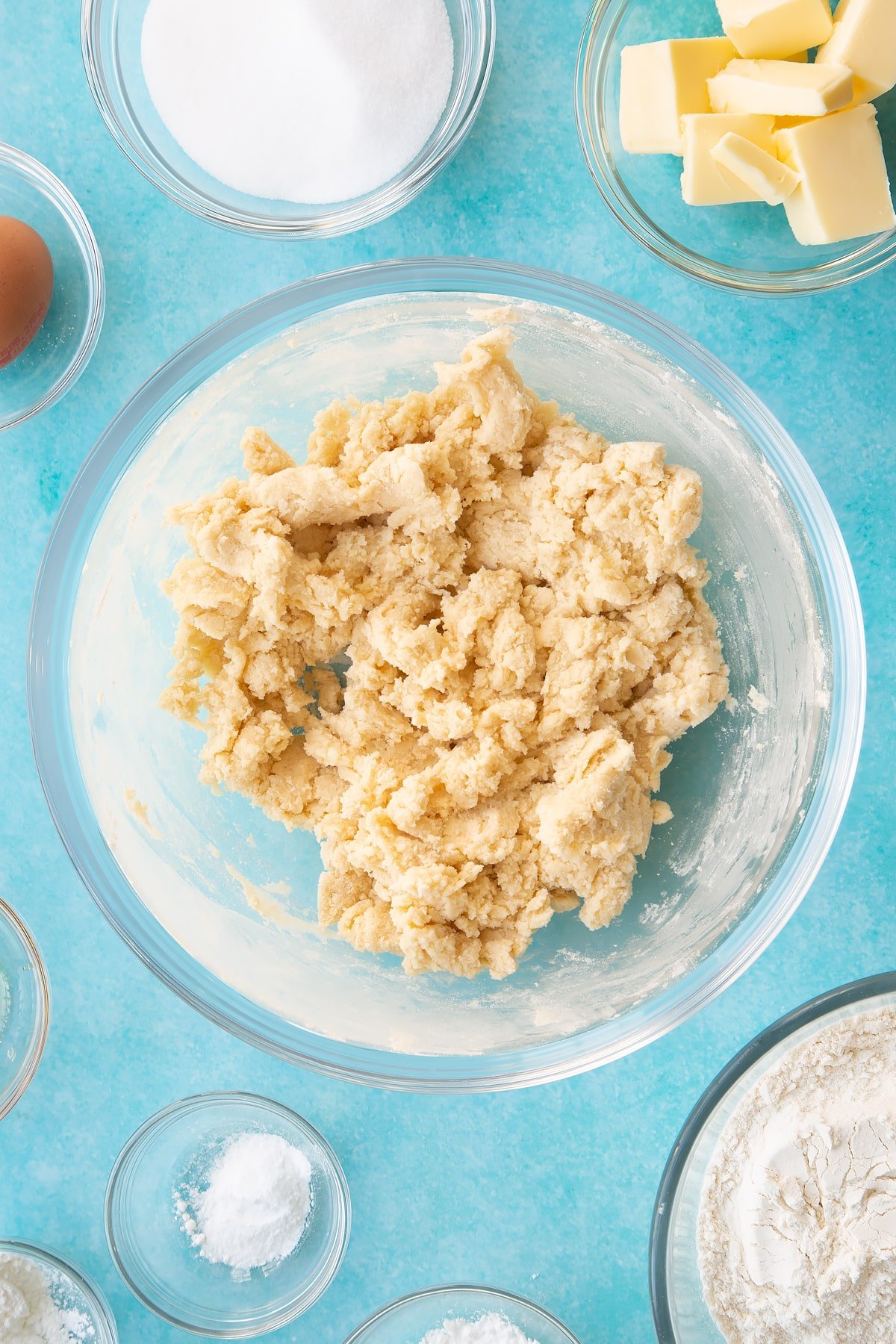
Gather up the pieces and knead together only as much as it takes to get a smooth ball of dough.
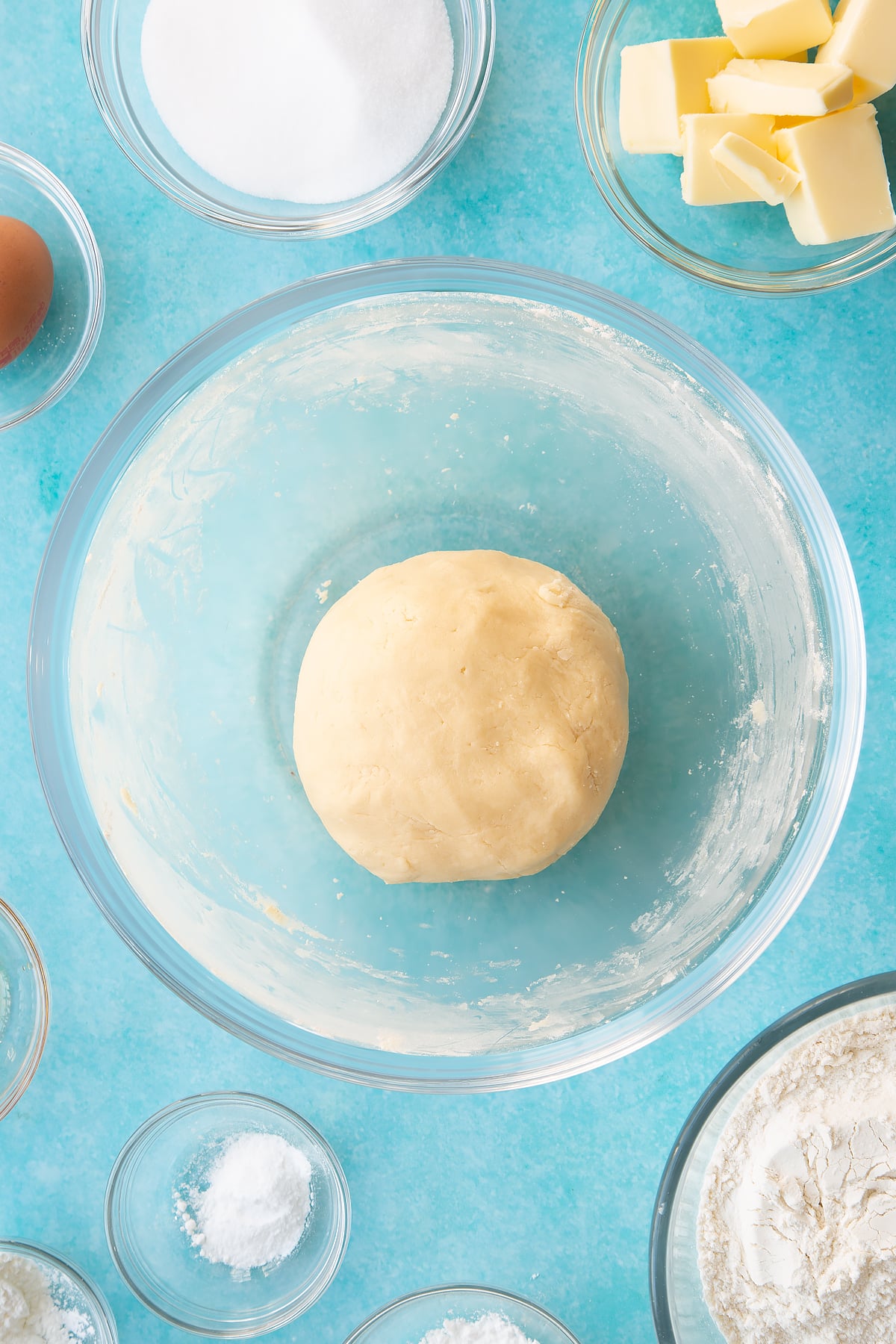
Wrap and place in the fridge to rest and chill for 15 minutes.
Make the icing toppers
While the cookie dough is chilling, clean down your surface and dust with cornflour.
Knead the white sugar paste to soften and divide into four pieces. Add a tiny bit of food colouring to each, leaving one white.
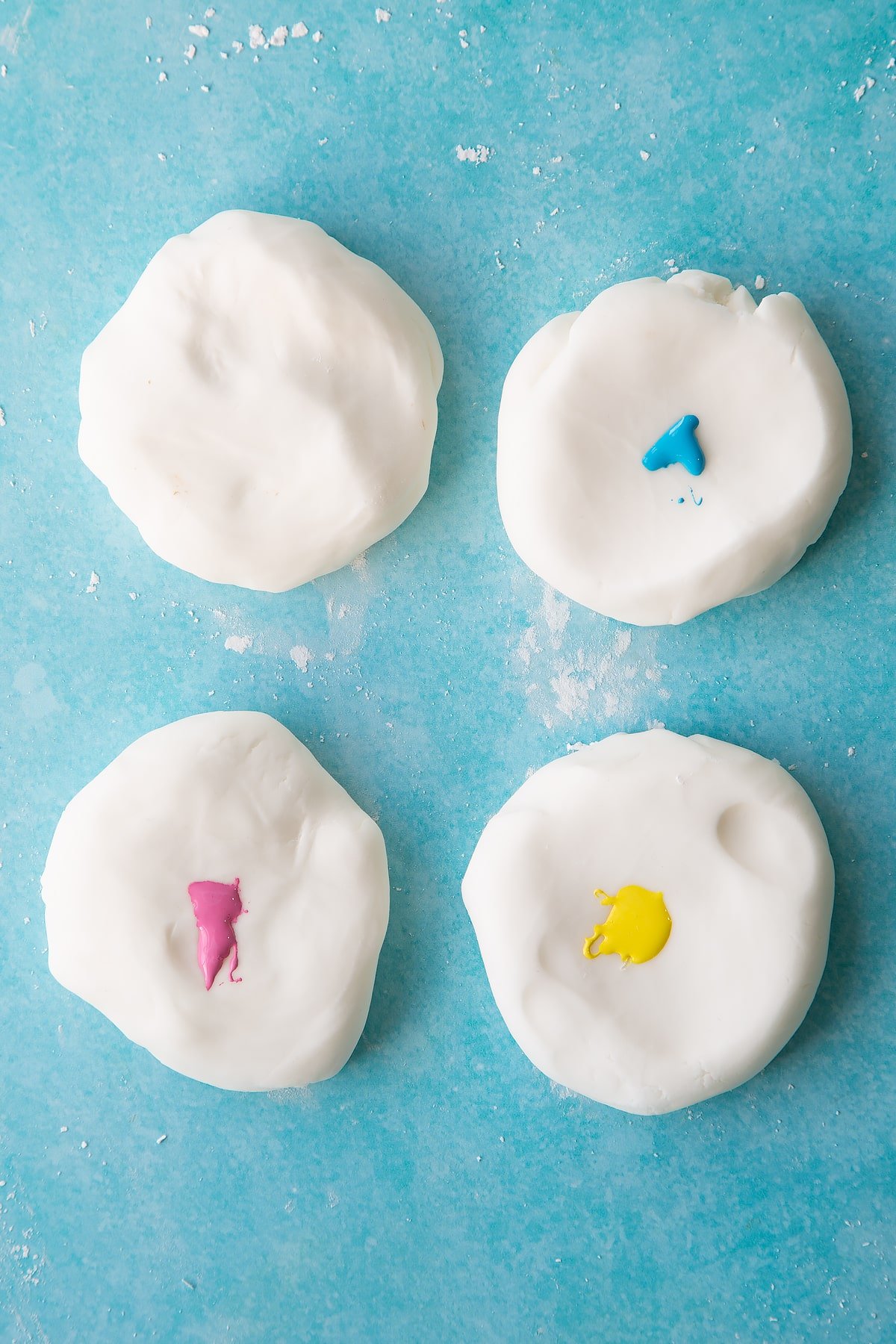
Knead to produce three pastel shades.
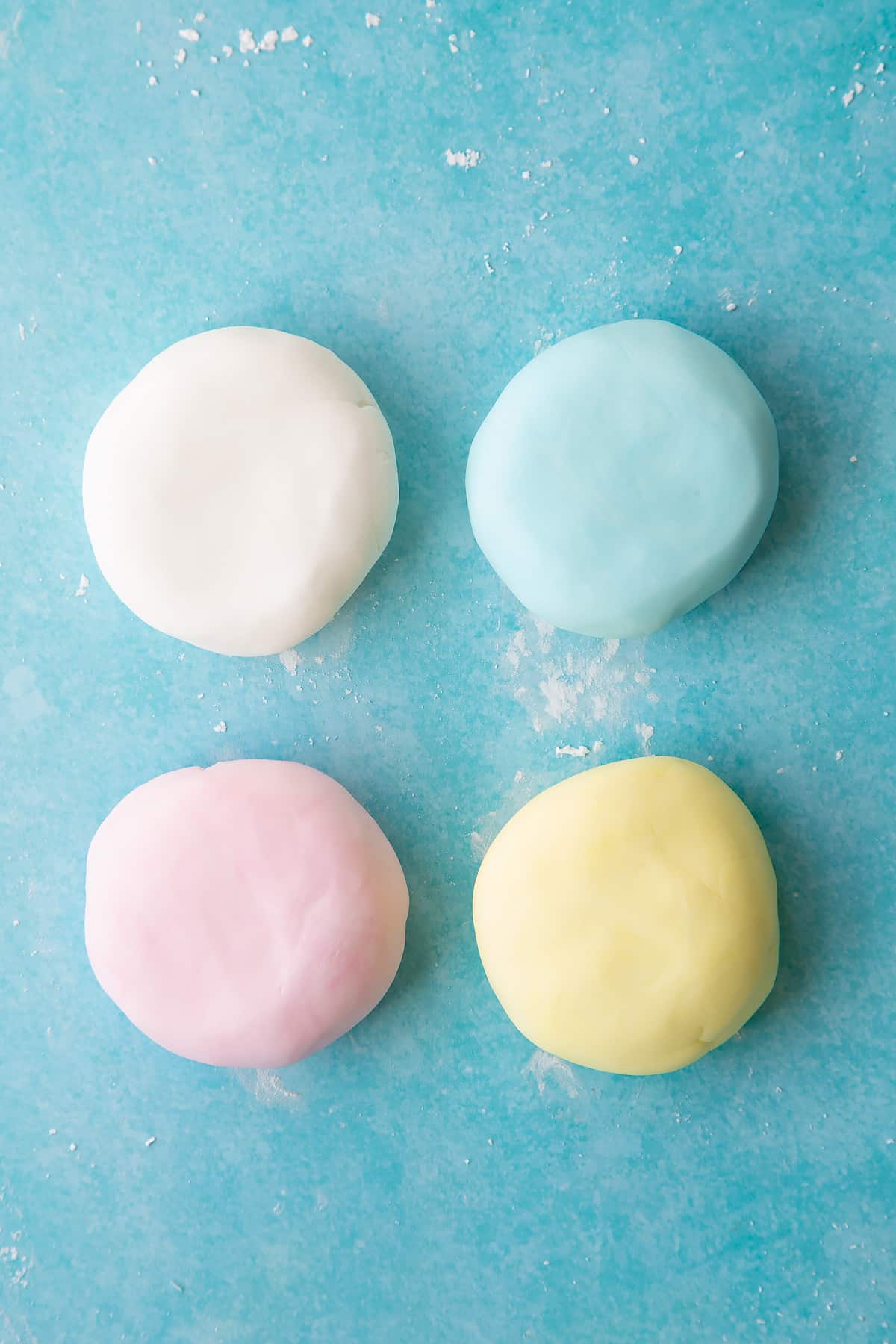
Break the balls of sugar paste into small pieces and drop onto the surface to form a mishmash of coloured pieces.
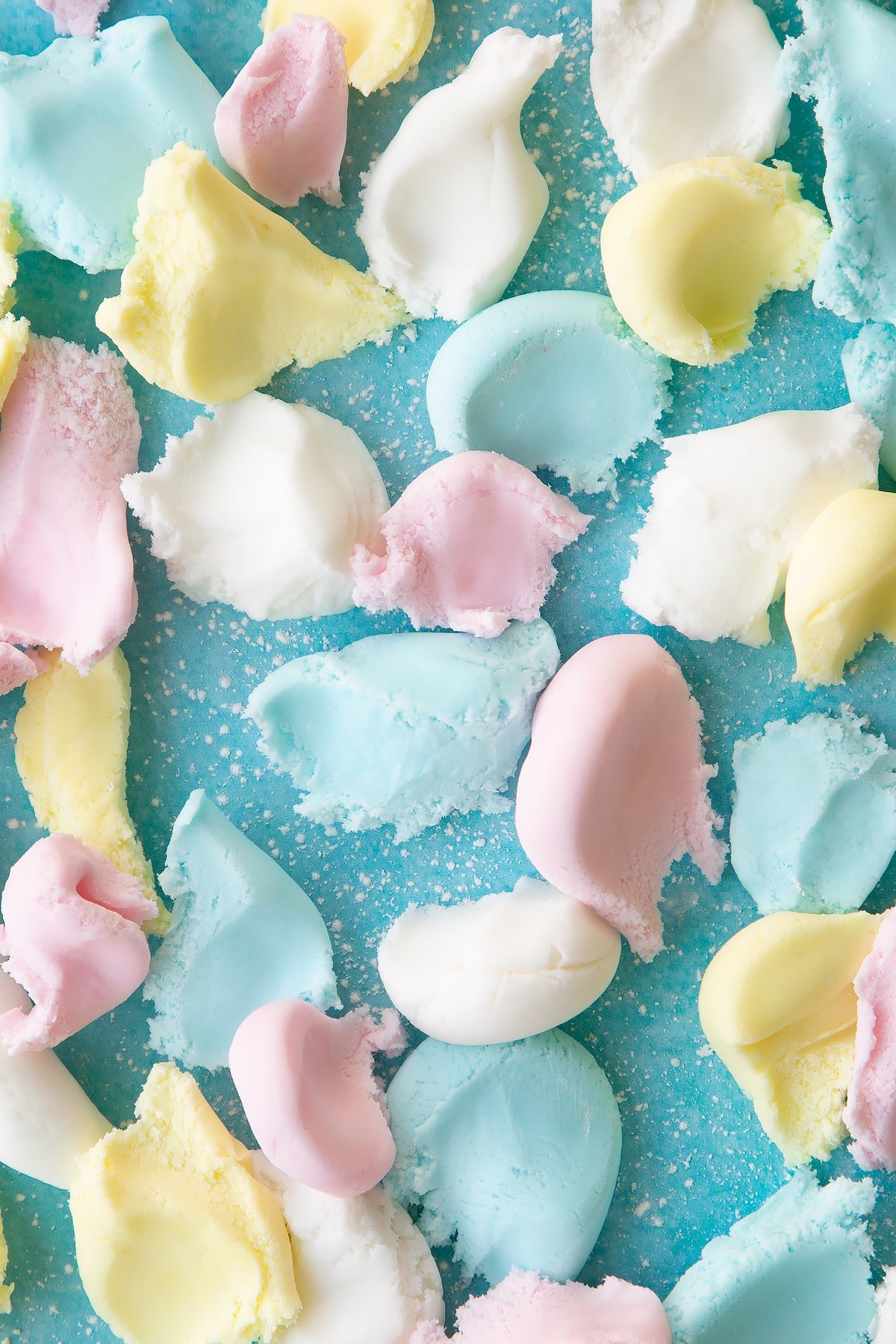
Gather it all together knead and twist briefly to produce a marble effect. Don’t overwork as the colours will merge into one.
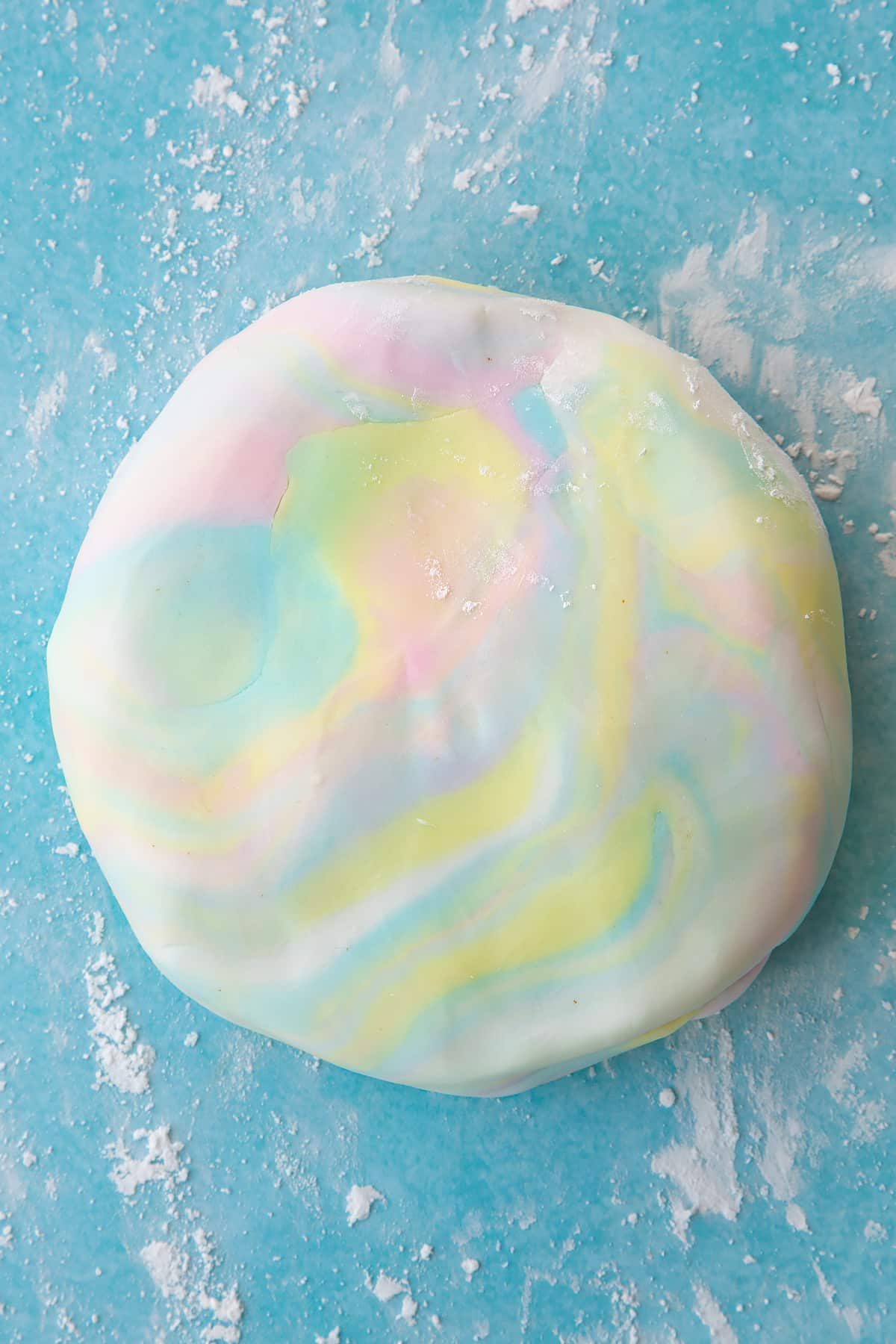
Roll the icing out to about half a centimetre (1/4 inch) thick.
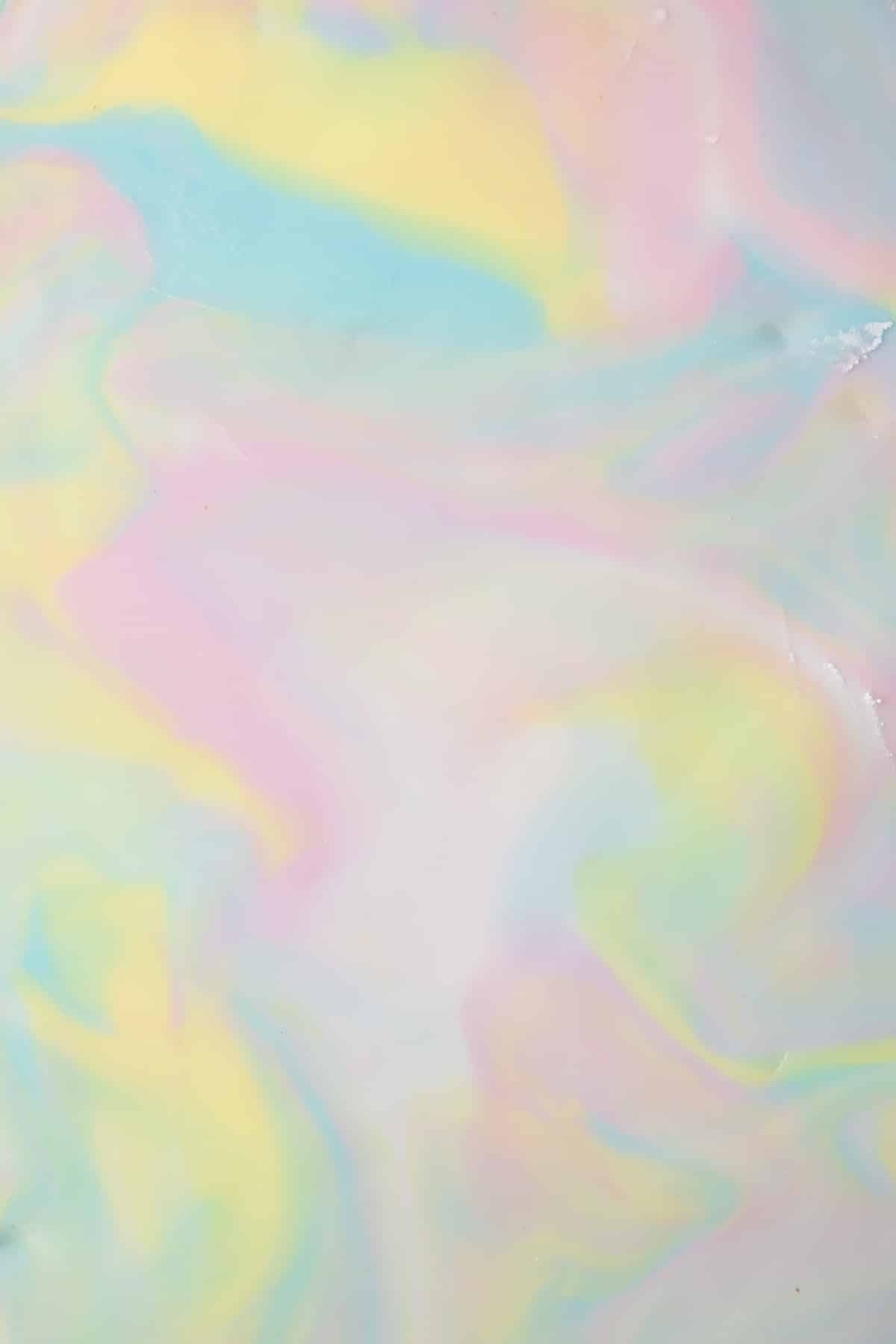
Cut out 20 egg shapes using your egg-shaped cookie cutter. Aim to cut them close together to reduce the need to gather and re-roll the sugar paste as the colours will merge.
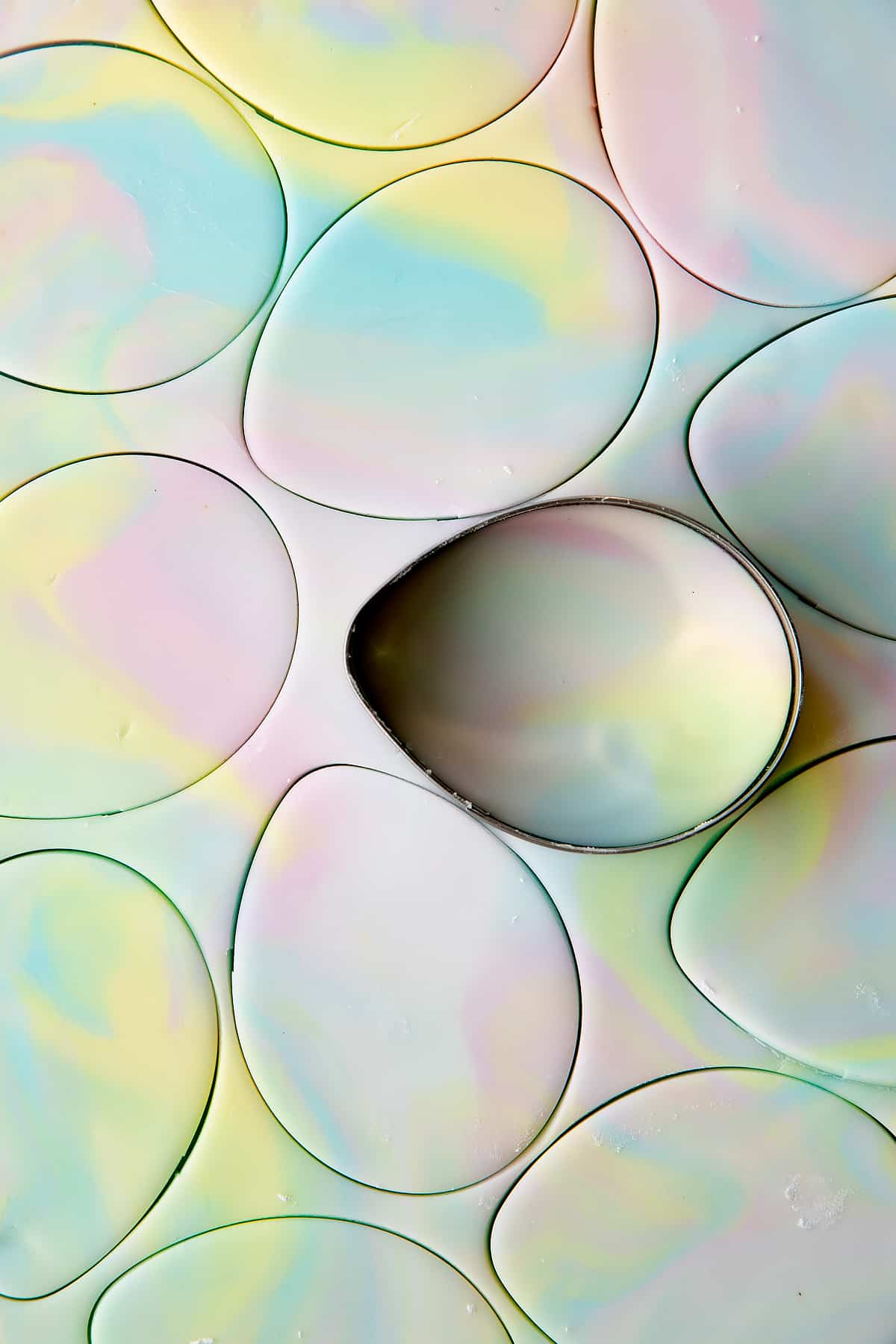
Place the sugar paste eggs to one side on a board lightly dusted with cornflour so that they stay flat.
Shape and bake the cookies
Clean your surface and dust with flour. Retrieve your chilled cookie dough and roll it out to approximately 7-8mm thick (approx 1/3 inch).
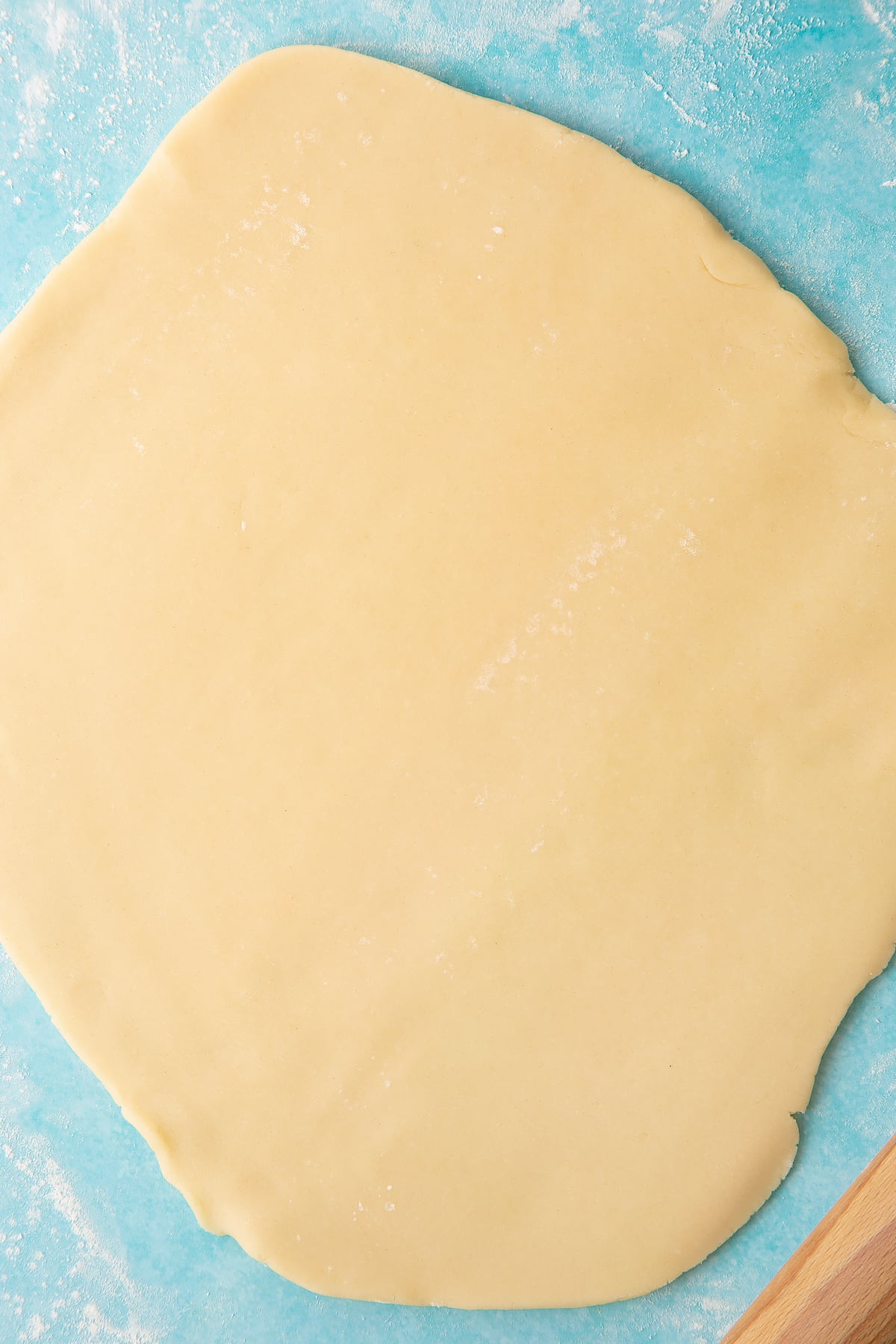
Cut as many cookies as you can with the same egg-shaped cookie cutter your used for the sugar paste. Again, aim to cut them close together to reduce the need to overwork the dough by gathering and re-rolling too many times. You should get 20 cookies .
Place the cookies on a lined baking sheets as you cut them out. They don't need to be spaced more than a centimetre of two (half inch) apart as they only spread a little bit.
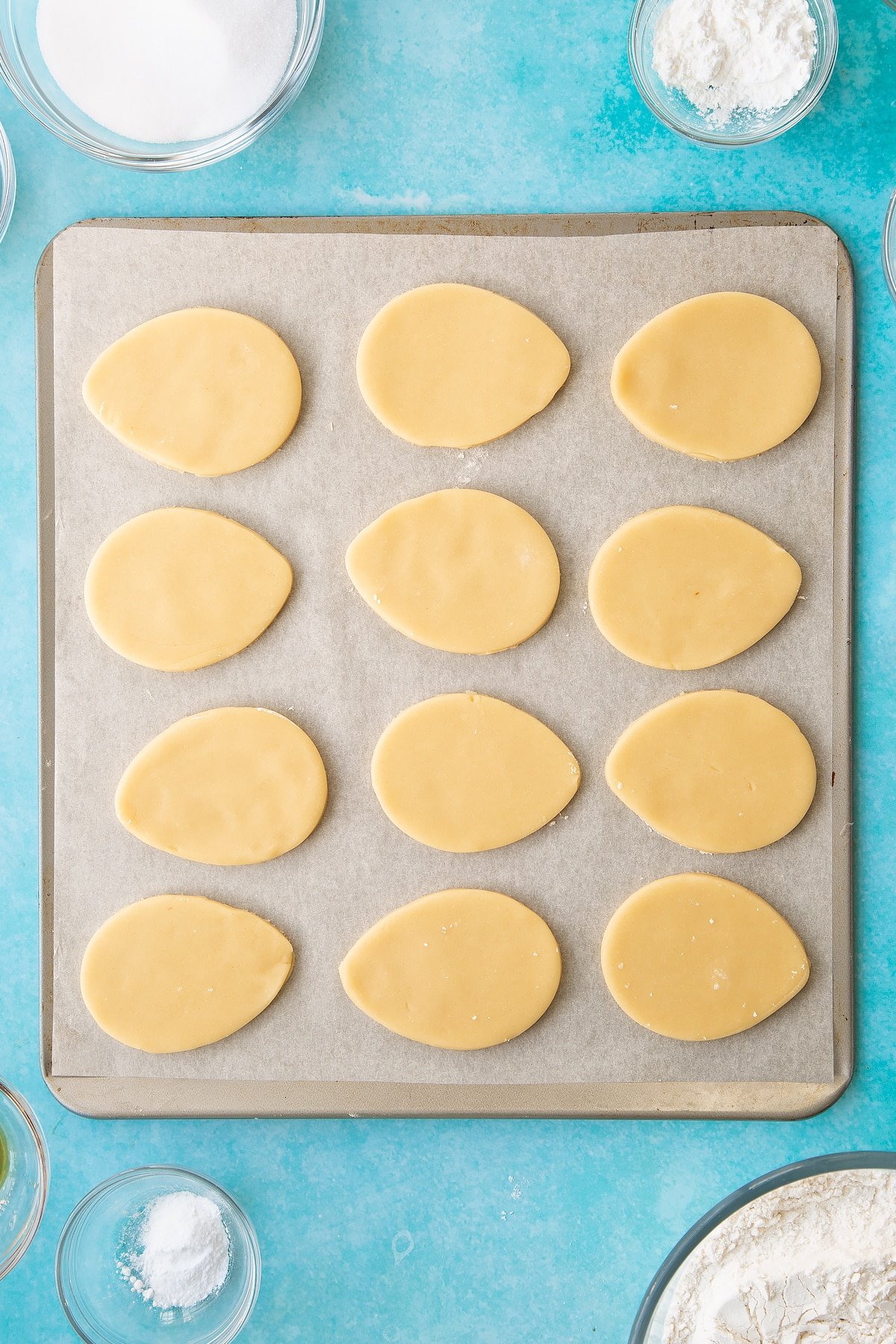
Bake the cookies for 8 minutes or until pale golden at the edges.
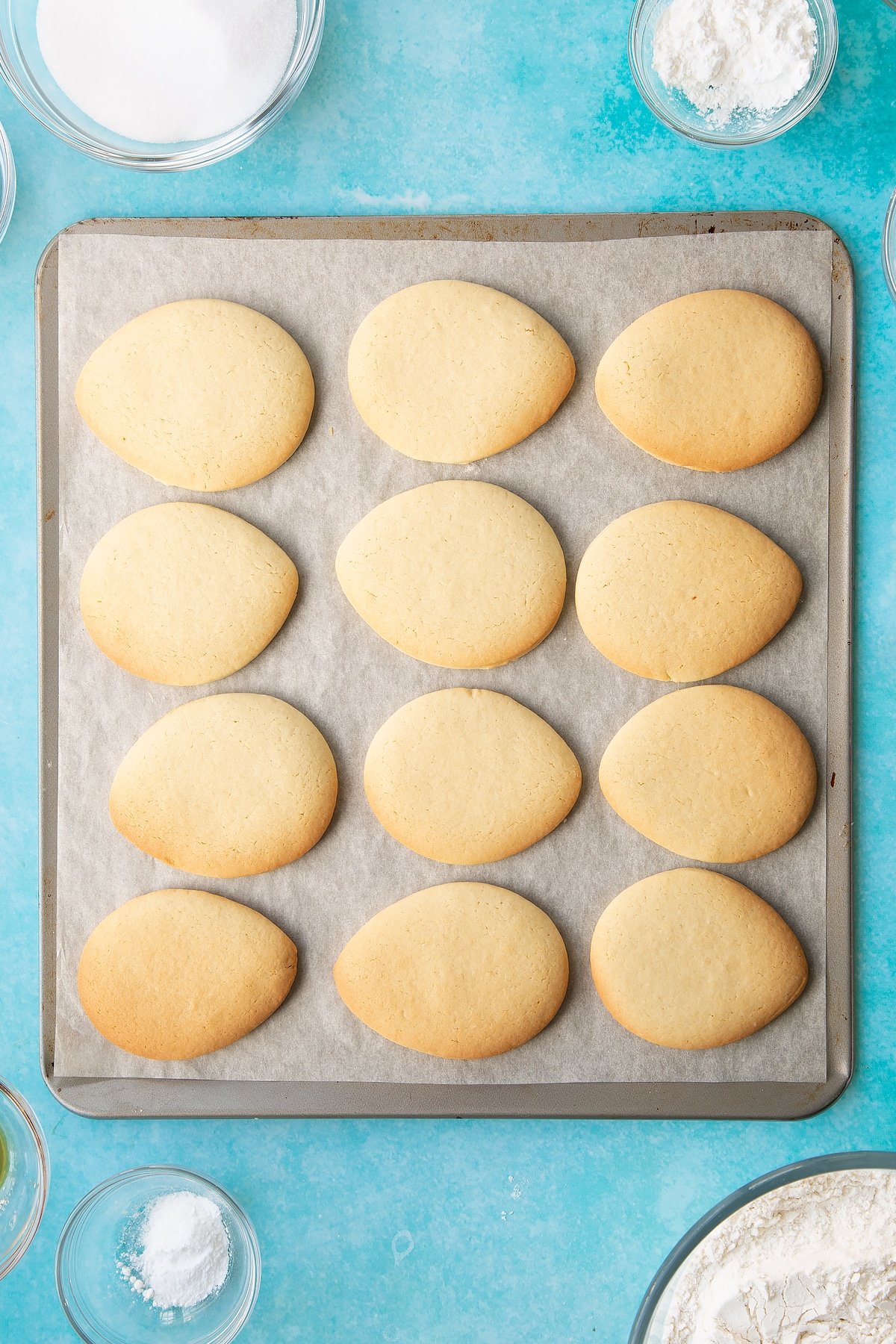
Decorate the cookies
In a small container, mix the icing sugar with a teaspoon of water until dissolved to make a 'glue'.
Brush the warm cookies with the 'glue'.
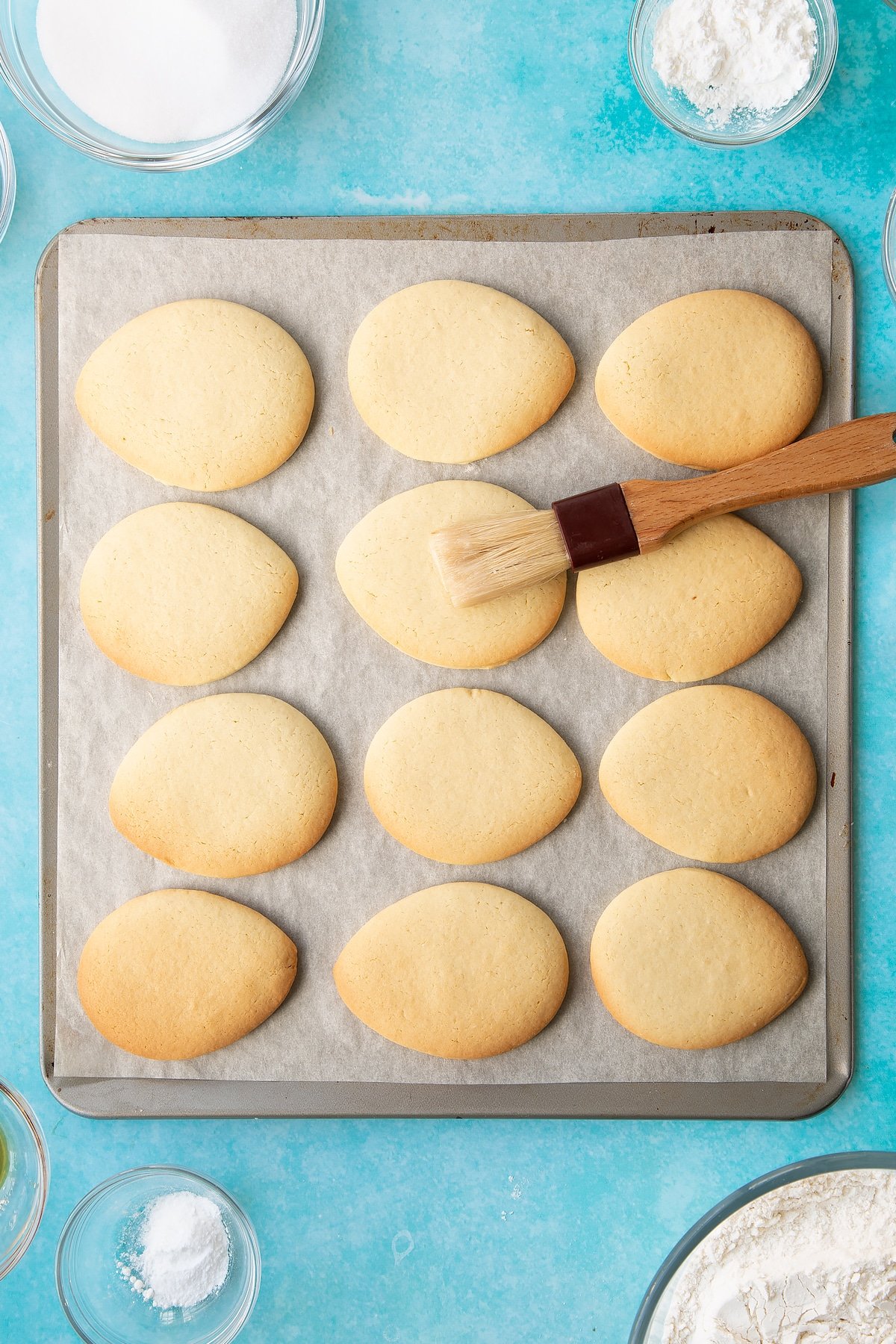
Place a sugar paste heart on top. Repeat until all the cookies are iced.
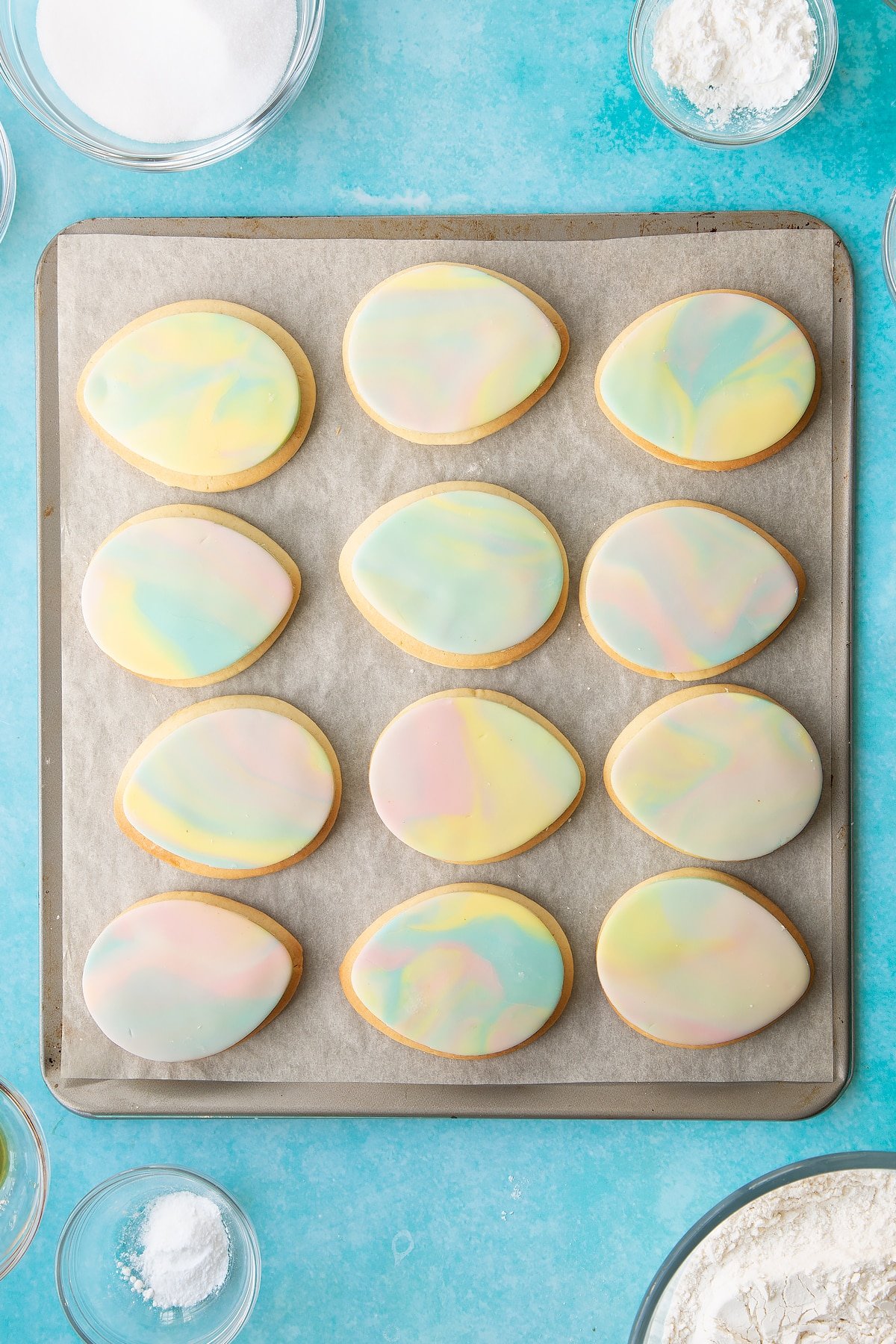
Transfer the cookies to cooling rack to cool and crisp up. Then enjoy!
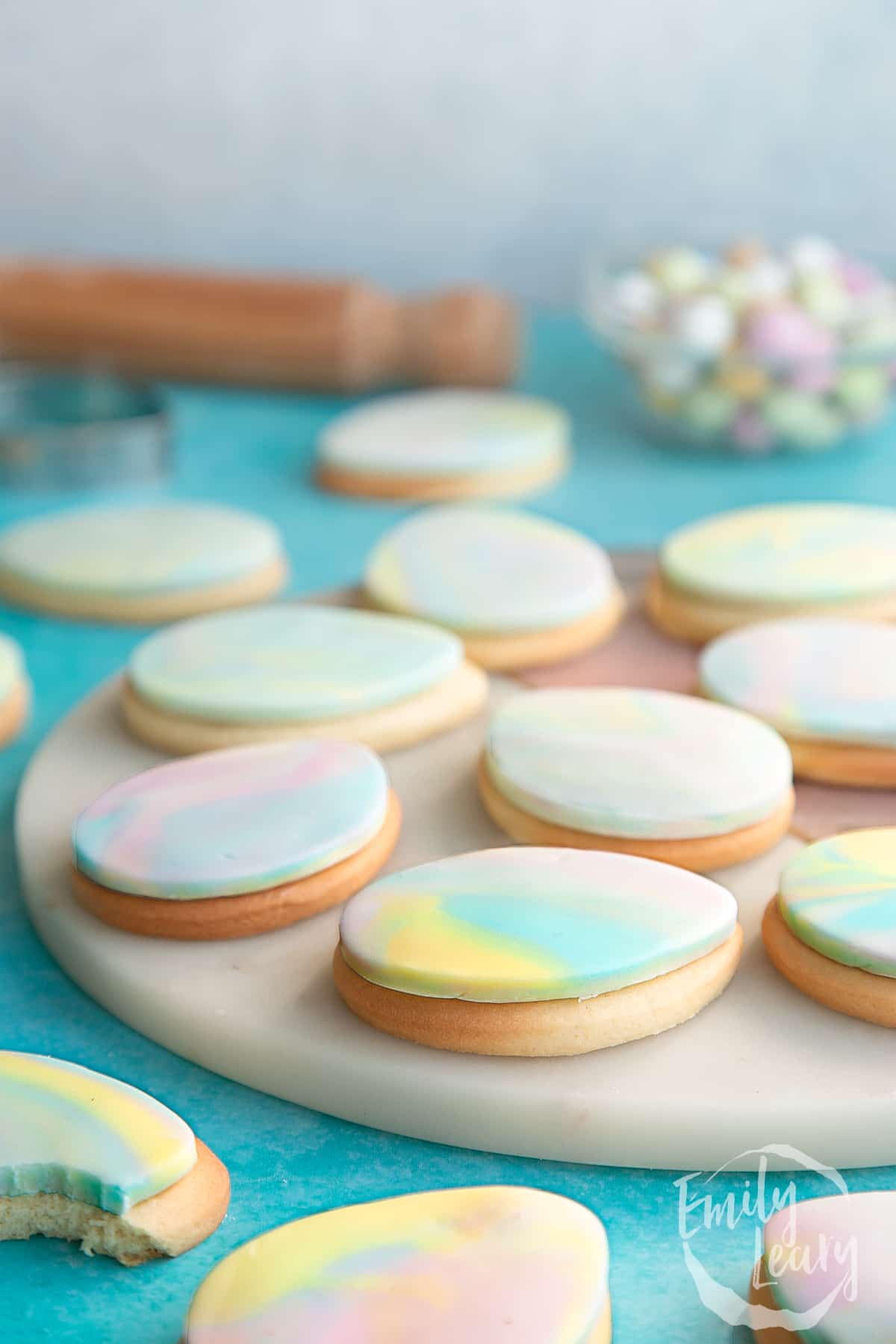
Pointers, tricks and troubleshooting tips for the perfect Easter sugar cookies
Are Easter sugar cookies easy to make?
Don’t be intimidated by the marbled topping! These Easter sugar cookies are super easy to make if you follow the recipe to the instructions above.
I try to design my recipes so they give super consistent results, so if you follow the instructions in the recipe your cookies will look exactly the same as the picture.
The cookie dough is a classic sugar cookie recipe, made using butter, sugar, eggs, flour and raising agents. They only take 8 minutes to cook and they’re super easy to mix and put together.
The tricky part of the recipe is getting the sugar paste neat and flat. Luckily, I have broken the stage down into several parts and I’ve included pictures for every step. So you should be able to see exactly what you need to do and how it should look as you go along.
Hopefully, the recipe and FAQ section can help you get your cookies spot on, but let me know if you have any questions in the comments below!
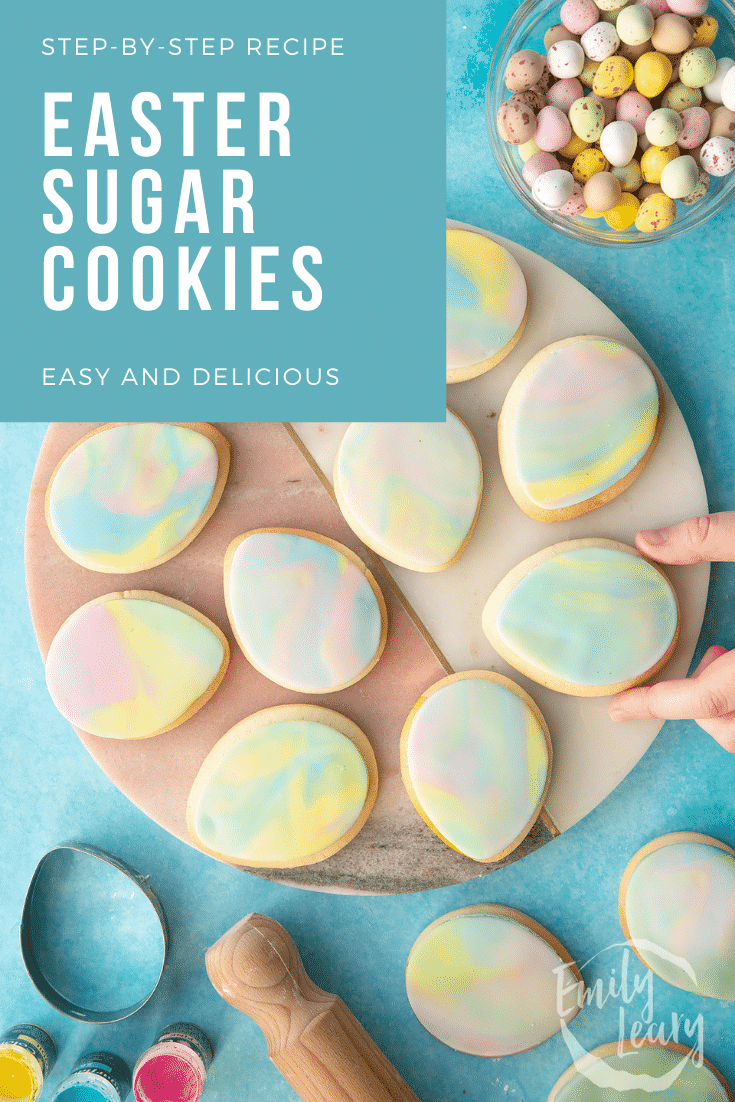
Will I need any special equipment to make Easter sugar cookies?
This recipe is a fairly standard cookie recipe, however, you’ll need a bit of unusual cooking equipment to decorate the cookies - a paintbrush!
Luckily, paintbrushes are easy enough to find in a supermarket on the stationary aisle or in your local Pound/Dollar store. Or, you could order a pack of paint brushes from Amazon.
If you’re in doubt, there’s always a full list of suggested equipment on the recipe card below my recipes. I always include links to example products, so you can see exactly what I used to make each recipe.
How can I tell if eggs have gone off?
While some chefs like to use older eggs for recipes like meringue, it's generally always best to use fresh eggs when baking. This is because eggs can behave differently in recipes as they get older and their quality declines.
You should never eat an egg that looks, smells, feels or tastes odd in any way. So if your egg has any discolouration, odd appearance, or a strange or foul odour, it is most likely rotten.
If your egg has spoiled, you should immediately throw it away and thoroughly wash any pots and utensils that have come into contact with it.
How can I tell if butter has gone off?
When butter spoils, it changes colour, texture and smells strange.
You can usually tell if butter has spoiled just by looking at it. Spoiled butter becomes a darker yellow colour, sometimes with translucent patches or a layer of condensation. This occurs when bacteria begins to break down the butter. This process also causes the butter to smell sour or rancid, as lactic acid is released.
So if your butter has any of these signs, you should discard it immediately.
Where can I buy food colouring? What kind should I buy?
Liquid food colouring is the most common type of food colouring. It's also very easy to use and usually affordable, which is why I use it in this Easter sugar cookie recipe. You’ll usually find liquid food colouring on the baking aisle of your local supermarket. However, you can usually find a wider range of colours on Amazon or specialist baking online retailers.
The quality and potency will vary depending on the brand you use, so try to find a trusted brand rather than a cheaper generic kind. Progel is available from many online retailers in the UK. It’s an affordable brand which offers a wide range of colours.
You should always make sure that you use food colouring, which is in date, as it might become unsafe to eat or unstable over time.
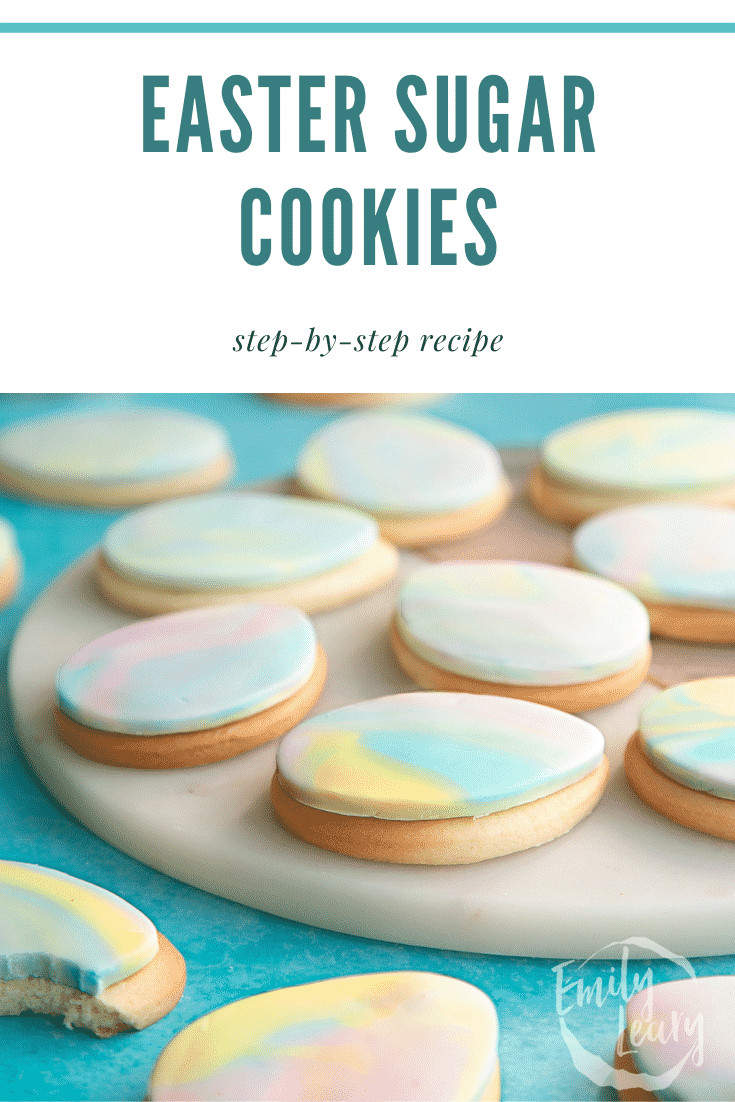
Are Easter sugar cookies suitable for vegetarians?
At the time of writing (April 2022), this recipe is completely vegetarian. However, remember to check all of your ingredients labels, as some brands can use animal derived ingredients.
Also, don't forget to check anything extra that you intend to serve with your recipe like sauces or creams.
Are Easter sugar cookies suitable for vegans?
These Easter sugar cookies aren't vegan, as they contain dairy and eggs. I haven’t tried making a vegan version of this recipe, but I’m sure it would work really well - or you could make my vegan Easter biscuit recipe.
You would only need to substitute the egg and butter in this recipe to make it vegan, so it could work with these substitutions:
Butter: For a vegan butter substitute, I usually use Flora Plant Butter, as it’s widely available, has similar fat content to dairy butter and they make a salted and unsalted version. Whichever brand you use, make sure you pick vegan butter with a fat content of around 80% - the same as dairy butter.
Egg: I usually recommend a list of homemade egg alternatives, but for this recipe, I think it would be best to use a shop-bought, prepared vegan egg substitute like this egg replacer from Amazon. This is because the texture and moisture levels of the homemade egg replacers might be too wet or dry for this recipe, but prepared egg replacements tend to be more exact.
Animal-derived products can be used to thicken, colour or flavour sweet and savoury food, so it sneaks into the most surprising ingredients! So make sure that you double-check all of your ingredients labels, even if you assume it’s vegan. Also, don't forget to check anything extra that you intend to serve with your recipe.
Are Easter sugar cookies gluten-free?
These Easter sugar cookies aren’t gluten-free, but they’re super easy to make gluten-free!
I haven’t tried this recipe with gluten-free flour yet but you could give it a go if you want to make them gluten-free. All you need to do is substitute the wheat flour for a gluten-free alternative.
Doves Farm makes a widely available gluten-free flour which you can find in most supermarkets.
Or you could try my gluten-free, vegan Easter biscuit recipe.
Double-check all of your ingredients labels to make sure that they are gluten-free. Don't forget to check anything extra that you intend to serve the recipe with.
Are Easter sugar cookies keto-friendly?
Unfortunately, these cookies are decidedly anti-keto. They contain sugar and carbohydrates, so they wouldn't suit the needs of a ketogenic diet. Sorry!
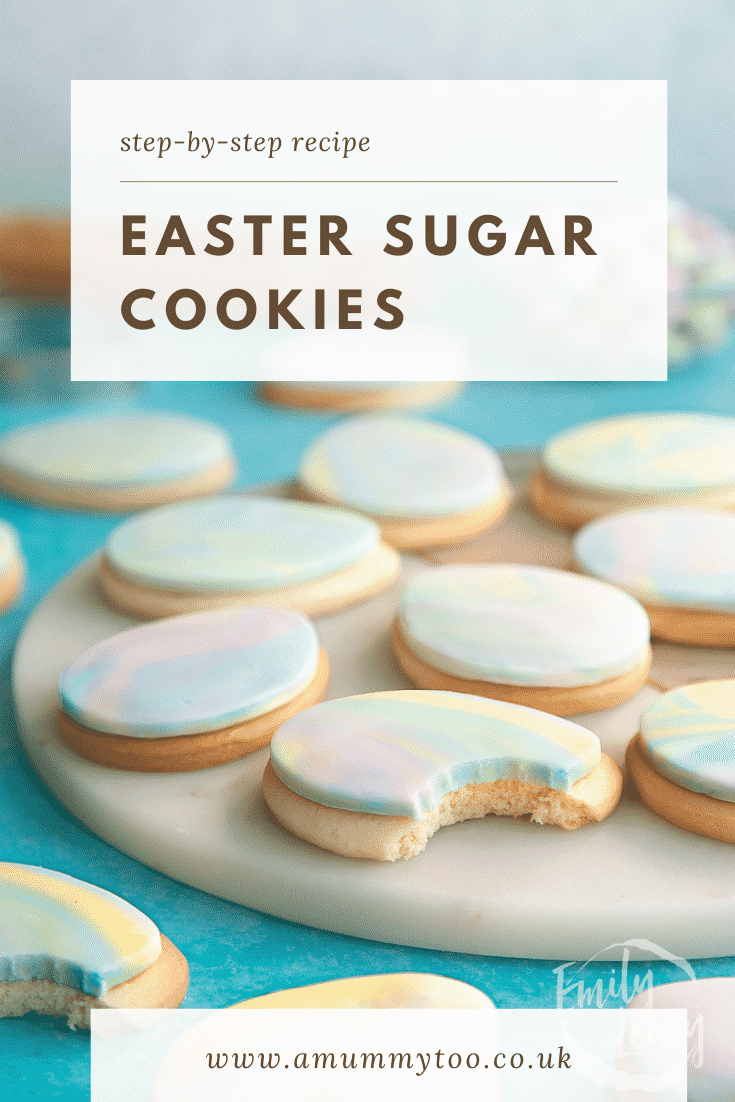
Are Easter sugar cookies healthy?
These Easter sugar cookies contain a fair amount of sugar from the sugar paste, so they aren’t the healthiest treat. But it’s fine to enjoy a sweet treat every now and then, especially if you usually eat a healthy and varied diet that helps fuel your lifestyle.
Are Easter sugar cookies safe to eat while pregnant?
There’s nothing in this recipe that would be unsafe for a pregnant person, so feel free to give them to a pregnant loved one as an Easter treat!
Make sure that all of your ingredients are in good condition and that this meal is prepared safely and hygienically.
A Mummy Too does not offer medical advice. Please seek help from a medical professional if you need further information or have any concerns.
What goes well with Easter sugar cookies?
These Easter sugar cookies will go with a nice hot drink like hot chocolate, tea or coffee. I find they tend to work best at the end of a long day when you’re sitting down and everyone is being very quiet.
Can I make these Easter sugar cookies without food colouring?
If you don’t want to colour your sugar paste, then that’s fine. Though your Easter sugar cookies will look pretty plain with just white tops.
If you’re conscious about making a mess with food colouring but you still want to decorate your cookies, you could use food pens to draw on the plain white sugar paste. It could also be a really fun way for children to get involved and customise their own biscuits.
You can find food decorating pens on the baking aisle of most supermarkets, or you can usually find them on Amazon in multipacks.
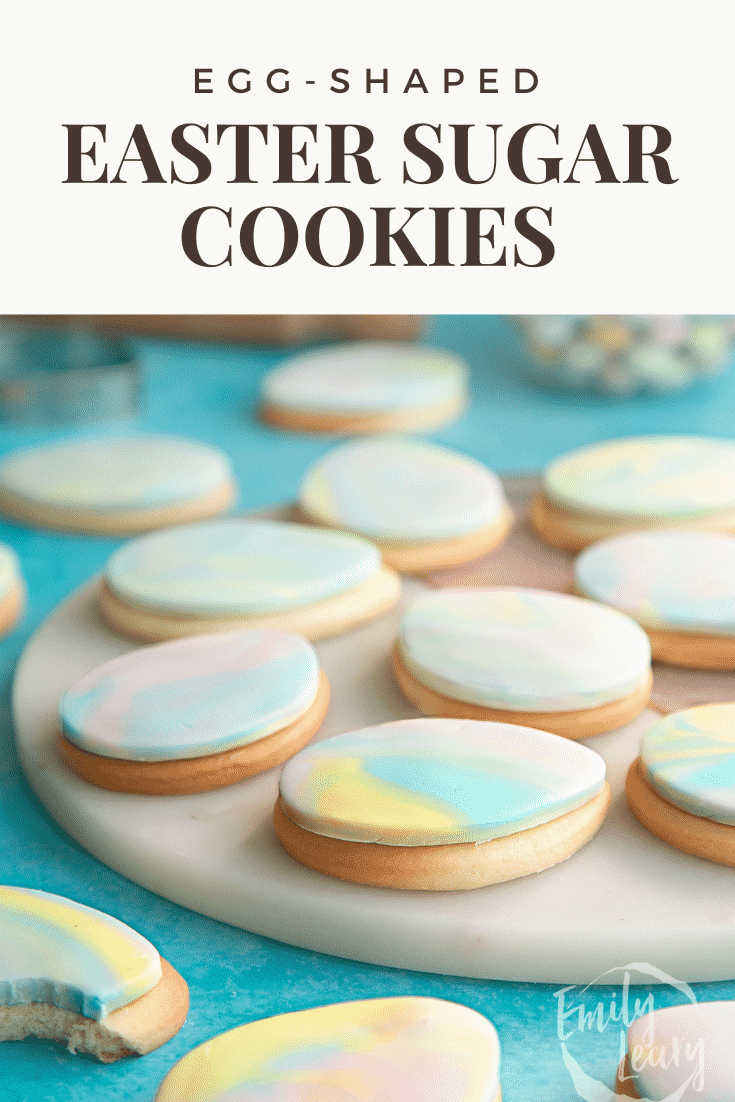
Is food colouring bad for you?
Food colouring can be a bit of a tricky ingredient if your family is trying to avoid food additives. Many food colourings include additives that can cause hyperactivity in children. Or, if you're vegetarian or vegan, food colouring be something to watch out for, as it can contain animal-derived ingredients.
Food additives are given 'E numbers' in the EU. E numbers aren't always bad for you. An E number is just a name given to chemicals in food so that regulators can monitor food quality. In fact, many natural ingredients (like Vitamin C) are known by E numbers.
However, there are some additives commonly found in food colouring that can cause hyperactivity. So if your child is sensitive to ingredients causing hyperactivity, these are the food additives you might want to avoid;
- E102 (tartrazine)
- E104 (quinoline yellow)
- E110 (sunset yellow FCF)
- E122 (carmoisine)
- E124 (ponceau 4R)
- E129 (allura red)
The NHS has a great explainer and list of food additives that can impact behaviour in children.
It's important to remember that all of these ingredients have been deemed safe to eat (in moderation) by regulators. So don't worry if you use food colouring that includes these additives.
A Mummy Too does not offer medical advice. Please seek help from a medical professional if you need further information or have any concerns.
Where did you get sugar paste?
You can usually find sugar paste on the baking aisle of your local supermarket, or failing that, it’s available from Amazon.
Sometimes sugar paste is listed as ‘ready to roll icing’. You can also use fondant icing as they're usually interchangeable. Fondant icing is similar to sugar paste, only it doesn’t set completely solid and it’s more prone to absorbing moisture and getting soggy.
So if you don’t mind that, fondant icing will work fine in a pinch.
Can I add chocolate to this recipe?
This is one of the few chocolate free Easter recipes I have - so if you’re looking for chocolate Easter cookies, I have a few other options on the site.
If you're set on adding chocolate to this recipe, you could add some cocoa powder to the cookie dough. Or you could drizzle the cookies with some melted chocolate, instead of using the sugar paste.
How should I store Easter sugar cookies?
The best way to store your Easter sugar cookies is to pop them into an airtight container, between layers of baking paper to protect the decorations from damage. Then keep the container in a cool dark place like a cupboard or a pantry.
How long will Easter sugar cookies keep?
If you store them correctly, you Easter sugar cookies will be safe to eat for up to 5 days. However, they will start to get soft within a day or two, so they're best enjoyed as fresh as possible.
Can I leave Easter sugar cookies out on the counter?
It’s not a good idea to leave your cookies out on the counter, as they will turn stale and the sugar paste will probably get sticky, and covered in flies - yuck!
Can I make Easter sugar cookies ahead?
Sure, your cookies should stay nice and crisp for up to 2 days, as long as you store them in an airtight container. Make sure your container is completely airtight, otherwise the cookies will become soft very quickly.
Can I keep Easter sugar cookies in the refrigerator?
You can keep your Easter sugar cookies in the fridge, but they will most likely turn soggy due to the way moisture behaves in fridges. So its best to keep your cookies in an airtight container in a cool cupboard or pantry.
Can I freeze Easter sugar cookies?
Yes! This recipe is great for freezing as it has a low water content, so it shouldn't impact the quality of your cookies too much. Best of all, both the raw cookie dough and the baked cookies will freeze well.
If you freeze the dough, wrap it tightly in cling film, or pop it into a sealable sandwich bag and tie it tightly. Then label it so you know what kind of dough it is - you don't want to accidentally use your cookie dough for pizzas or flatbreads! The cookie dough should keep in the freezer for up to 3 months.
To freeze the baked Easter sugar cookies you can place them into an airtight container and label with the date and what’s inside. It's best to freeze your cookies undecorated, as the sugar paste will become more brittle when frozen, and most likely break off from the cookies.
The cookies will keep for up to 2 months in the freezer.
What is the best way to defrost Easter sugar cookies?
The best way to defrost your cookies or cookie dough is to place the container into the fridge and leave it overnight. Or you can defrost an individual cookie by leaving it out on a plate on the counter for an hour or so.
Can I make these Easter sugar cookies in a different quantity?
If you want to make more or less of this recipe then that’s fine! You can use an online recipe calculator to change the size of the recipe while retaining the correct ratios.
The cook time and temperature will remain the same, as long as you make the cookies in the same size shown in the recipe above.
Can I make Easter sugar cookies in a stand mixer such as a KitchenAid or Kenwood Mixer?
A stand mixer would be useful for mixing your ingredients together. You would probably be best off using a balloon whisk attachment to cream together the butter, eggs, sugar and vanilla. Start slowly then build up the speed until they are light and fluffy.
Then scrape down the sides of the bowl and sift in the dry ingredients. You can keep the balloon attachment, and gently mix the ingredients so that they form a loose, pebble like consistency. Then follow the rest of the instructions as usual.
Can I make Easter sugar cookies with a food processor?
You could blitz together the ingredients for your cookie dough, but make sure not to blitz it too much. You want a light crumb, not a paste! Once your ingredients are mixed into a crumb you can empty them out and bring it into a big ball by hand. Then follow the instructions as below.
How can I make sure my Easter sugar cookies turn out perfectly?
To make sure your Easter sugar cookies turn out perfectly, you should follow the recipe steps exactly. I designed this recipe to give you super consistent results, so if you follow it, you should have the same cookies that I made.
If you’re unsure or confused at any point, you can check the photos above to see if your recipe looks correct.
The main thing to watch out for with the cookies are the timing. These cookies take less than 10 minutes to cook, so they can quickly burn if you leave them for too long.
For the decoration, the cornflour is key. It stops the sugar paste from sticking to the counter, and keeps the edges of the paste from curling up before you fix them too your cookies. However, you should remember to dust it off the icing shapes before you fix them to the cookies - otherwise you might end up with a bit of a gluey texture from the cornflour.
Why did my Easter sugar cookies turn out burned/crumbly?
If your cookies have turned out very crumbly and you added the correct amount of ingredients, then they might have overcooked. The cookies should only take 8 minutes to cook. Any longer and they will dry out and most likely burn. If you cooked them for the right amount of time but they're still dry, then your oven may have been too hot.
Many domestic oven temperature dials are not accurate, so your oven may just run a bit hot. If you want to check this then you could invest in an oven thermometer.
An oven thermometer is an oven-safe thermometer that you can put in the oven before cooking to check it’s at the right temperature. Or you can keep it in the oven and it will let you monitor the temperature as you cook. You can usually find them on Amazon.
Why did my Easter sugar cookies turn out wet/soft/dense?
There aren't many wet ingredients in the recipe for your Easter sugar paste dough, so you should end up with a lovely crisp base for your sugar paste decoration.
Why didn’t my Easter sugar cookies rise?
Your cookies don't need to rise too much, so if they’re still quite flat then everything is working just fine. The baking powder and bicarbonate of soda in the recipe are only there to give them a bit of a fluffier texture.
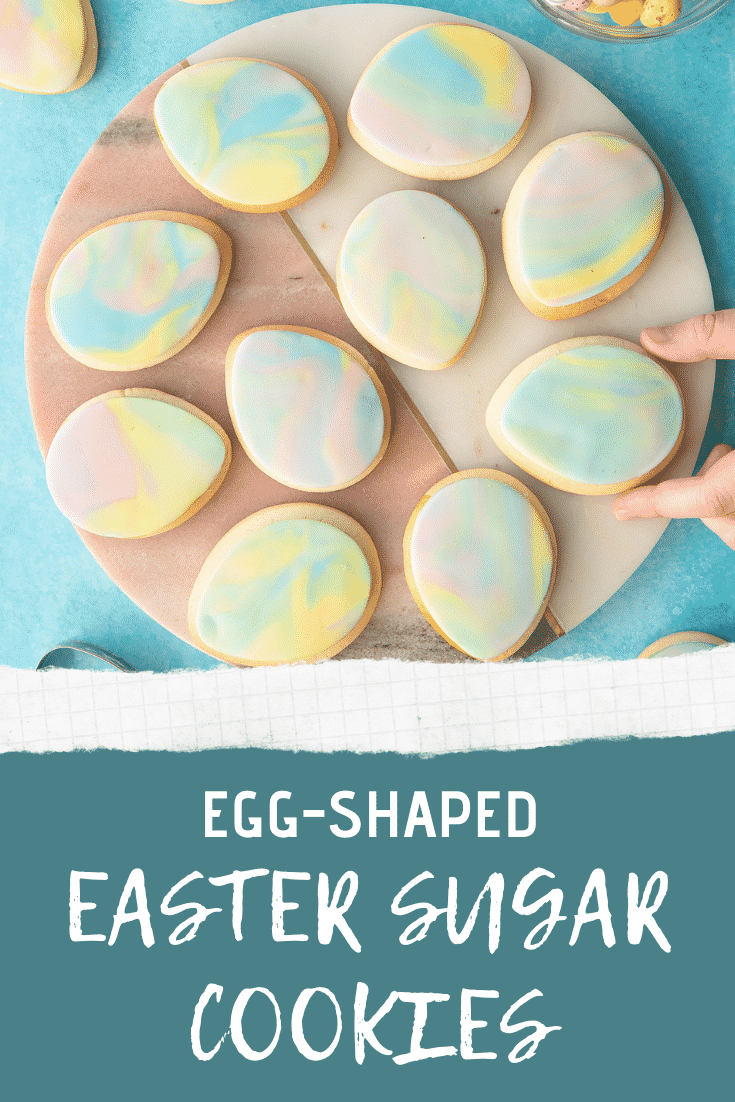
How can I add/change the flavours in these Easter sugar cookies?
These cookies have quite a neutral base, so feel free to add some extra flavour to the cookie dough. I used some vanilla extract, but you could use any other food flavouring like orange, mint, salted caramel, coffee, or even artificial fruit flavourings.
Where is the origin of sugar cookies?
Like most modern sweet treats, sugar cookies were invented in America in the mid-late 1700s.
Historians believe that the first sugar cookies, or something similar, were made in a town called Nazareth, in Pennsylvania. German settlers there created a round, crumbly and buttery cookie which became so popular in the area, that it was named the Nazareth Cookie.
Published recipes became widespread in the 1800s, and variations of sugar cookie recipes began to develop and spread. Today, sugar cookies are used as a base for many seasonal treats, as they’re so easy to decorate and customise with different flavours and toppings.
Print Easter sugar cookies recipe
Easter Sugar Cookies Recipe
Ingredients
For the sugar cookie dough
- 110 g (1 stick) slightly salted butter cubed
- 100 g (½ cup + 1 tbsp) white caster sugar (superfine sugar)
- 1 medium free range eggs
- ½ tsp vanilla extract
- 250 g (1⅔ cups) plain white flour (all purpose flour)
- ¼ tsp bicarbonate of soda (baking soda)
- ¼ tsp baking powder
- ¼ tsp salt
To decorate the Easter sugar cookies
- 1 tsp cornflour (cornstarch) for dusting
- 500 g (18 oz) white sugar paste vegetarian, if required
- yellow, blue and pink food colouring to produce pastel shades
- 2 tbsp icing sugar (powdered sugar)
Equipment
- 8.25 x 6.25cm (3.25 x 2.5") egg-shaped cookie cutter
Instructions
Make the cookie dough
- Preheat the oven to 200C (180C fan assisted, 400F).
- Put the butter, sugar, eggs and vanilla in a mixing bowl. Whisk until fluffy and pale.
- Sift in the flour, baking powder, salt and bicarbonate of soda. Stir until fully combined and clumpy
- Gather up the pieces and knead together only as much as it takes to get a smooth ball of dough.
- Wrap and place in the fridge to rest and chill for 15 minutes.
Make the icing toppers
- While the cookie dough is chilling, clean down your surface and dust with cornflour.
- Knead the white sugar paste to soften and divide into four pieces. Add a tiny bit of food colouring to each, leaving one white.
- Knead to produce three pastel shades.
- Break the balls of sugar paste into small pieces and drop onto the surface to form a mishmash of coloured pieces. Gather it all together knead and twist briefly to produce a marble effect. Don’t overwork as the colours will merge into one.
- Roll the icing out to about half a centimetre (¼ inch) thick.
- Cut out 20 egg shapes using your egg-shaped cookie cutter. Aim to cut them close together to reduce the need to gather and re-roll the sugar paste as the colours will merge.
- Place the sugar paste eggs to one side on a board lightly dusted with cornflour so that they stay flat.
Shape and bake the cookies
- Clean your surface and dust with flour. Retrieve your chilled cookie dough and roll it out to approximately 7-8mm thick (approx ⅓ inch).
- Cut as many cookies as you can with the same egg-shaped cookie cutter your used for the sugar paste. Again, aim to cut them close together to reduce the need to overwork the dough by gathering and re-rolling too many times. You should get 20 cookies .
- Place the cookies on a lined baking sheets as you cut them out. They don't need to be spaced more than a centimetre of two (half inch) apart as they only spread a little bit.
- Bake the cookies for 8 minutes or until pale golden at the edges.
Decorate the cookies
- In a small container, mix the icing sugar with a teaspoon of water until dissolved to make a 'glue'.
- Brush the warm cookies with the 'glue', then place a sugar paste heart on top. Repeat until all the cookies are iced.
- Transfer the cookies to cooling rack to cool and crisp up.
Video
Nutrition
Pin these Easter sugar cookies
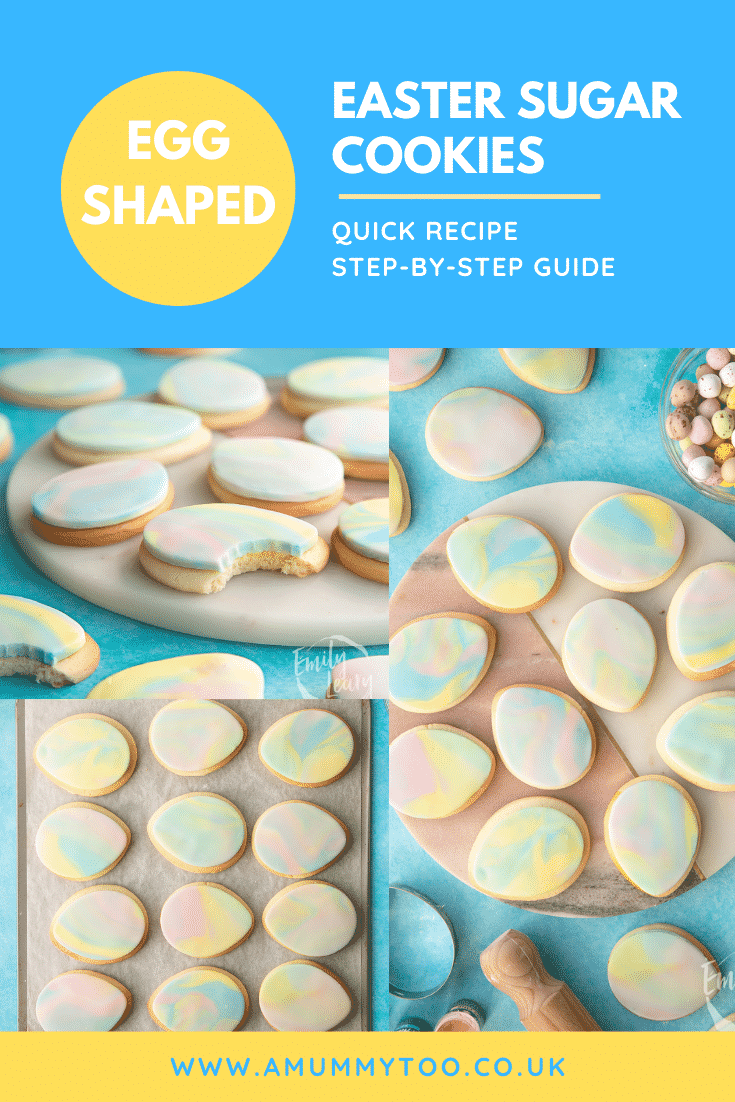
More Easter recipes to try
Have you got my book?

'This is a great kids cookery book. Emily is a star' - Simon Rimmer
'The book I'd like to force into any mother's kitchen' - Prue Leith
"A fab book with a plan." - Jane Devonshire, 2016 Masterchef UK winner
'Emily has managed to combine her mummy knowledge and passion for food to make a truly helpful and brilliant cookbook' - Priya Tew, RD, BSc (Hons), Msc
Get Your Kids to Eat Anything is an achievable 'how to' for parents in the battle to overcome picky eating and 'make new the norm'. Emily Leary's unique 5-phase programme looks at the issue of 'fussy eating' in a holistic way that links imagination with food, and which situates parents alongside - not in opposition to - their children.
.


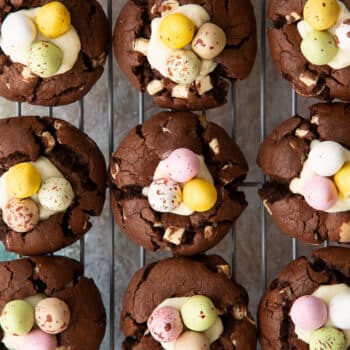

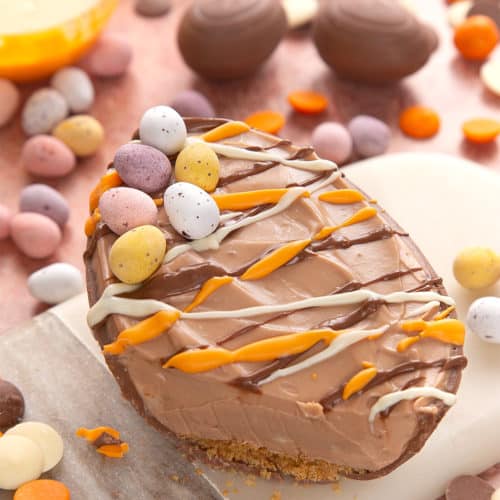

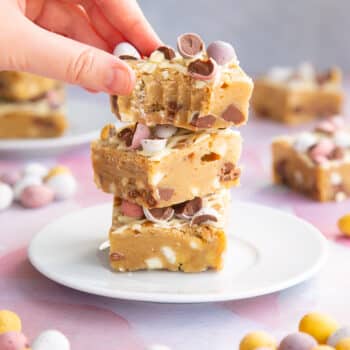
Leave a Reply